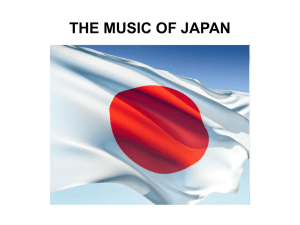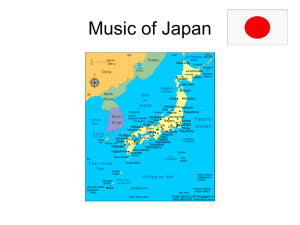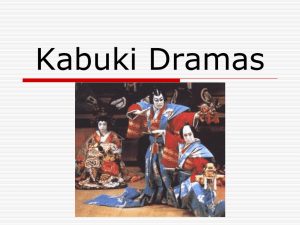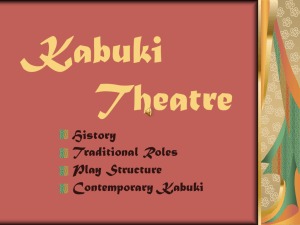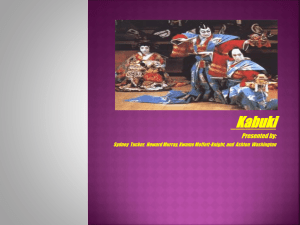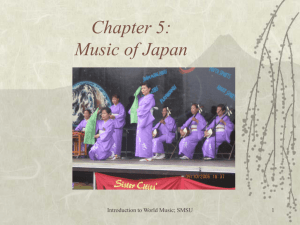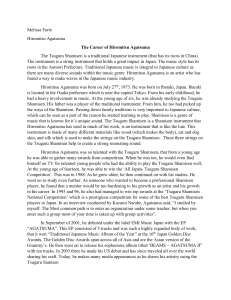Music of Japan MUSI 3721Y University of Lethbridge, Calgary Campus John Anderson
advertisement
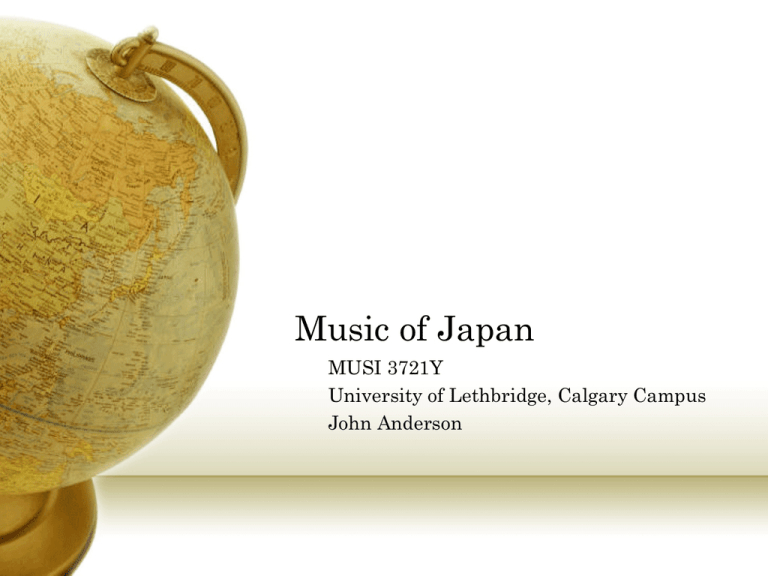
Music of Japan MUSI 3721Y University of Lethbridge, Calgary Campus John Anderson Cultural Values • In Japan, maintaining tradition is important • In pedagogy and performance, the emphasis is on playing music traditionally, without innovation • Preservation has tended to take a vertical path in Japan • Genres are transmitted from teacher to student through special lineages • No apparent horizontal influence from co-existing genres Social Class • Musical/theatrical genres tell us about Japanese history and social values • Genres are linked to social class and historical epochs • Gagaku remains a symbol of the authority of the Imperial court • Noh, the art of the samurai, emphasizes simplicity and personal enlightenment through self-understanding and self-reliance • Kabuki and bunraku illustrate the fondness of the townsfolk for theater Gender Issues • The koto is believed to originally have been a court musical instrument played by men • The shamisen was originally an instrument played by banished samurai who became wandering Buddhist monks who utilized the shakuhachi as a weapon when needed. • The shamisen was played by men in accompaniment to the various theater genres Gender Issues • However, women have come to play these instruments during the Edo period in sankyoku, an ensemble music that has been associated with the geisha • The term geisha literally means “arts person,” whereby most Westerners mistakenly think the term refers to prostitutes • Japanese women had been trained in the arts at one time to entertain gentlemen, yet today they are trained for arts recitals Gender Issues • In kabuki, women were banned as performers in 1629 due to the genre becoming associated with prostitution • In 1653, reforms were again made in kabuki, restricting young men as performers as well Heterophony • In ensemble music, certain instruments play the melody heterophonically • Others mark time in regular recurring ways • Heterophony: two or more performers playing the same melody, but with small differences in timing or ornamentation • Although ensemble textures are largely monophonic and/or heterophonic, great emphasis is placed on subtle differentiations of timbre and ornamentation Sensitivity to Tempo • Relatively slow tempos with constant, subtle fluctuations in basic pulse • Jo-ha-kyu aesthetic ideal is pervasive in both large and small forms: • slow introductory exposition (jo) • faster, more rhythmically regular middle section (ha) • and still faster, more intense drive toward the end (kyu) • often with a sudden slowing down at the end of a piece Kabuki Nagauta Music From the Play “Pojoji” • Nagauta music is played by the on-stage debayashi ensemble • A corps of shamisens and voices plus a noh hayashi • The ensemble has three main subgroups Kabuki Nagauta Music From the Play “Pojoji” • Nagauta is a lyric genre of shamisen music, also sung in unison chorus in kabuki • Shamisen is a three-stringed, long-nekced, freltless lute, plucked with a large plectrum • Debayashi literally means a “coming-out orchestra”; a music group in kabuki that comes out onstage to accompany a specific scene • Noh hayashi is a drum Kabuki Nagauta Music From the Play “Pojoji” Three subgroups 1. Voice accompanied by shamisens playing in unison • together they provide the basic melodic unit 2. One or more o-tsuzumi and ko-tsuzumi (large and small noh drums) • play a supporting rhythm 3. Nohkan and taiko • together play an independent line unrelated to the other subgroups Excerpt from Noh play Hagoromo (“The Robe of Feathers”) • This excerpt provides a brief example of the stately quality of the unison vocal music accompanied by the three noh drums • It is the story of a fisherman who captures the wings of an angel • Promises to return them if she’ll dance “Rokudan No Shirabe” • One of the most famous solo koto pieces, “Rokudan” or “Six Sections” • A koto is a 13-stringed zither with moveable bridges • It’s typical of danmono instrumental pieces in that it consists of several “steps,” or sections, known as dan • The term “shirabe,” which appears frequently in titles of Japanese instrumental compositions, means “investigation,” specifically with respect to the instrument’s tuning “Rokudan No Shirabe” • A short introduction of four beats precedes the piece, then each dan follows without break • Each dan contains 104 beats and is repeated several times with increasing variation • This makes it extremely difficult to tell where one dan ends and a new one begins “Rokudan No Shirabe” • The jo-ha-kyu structure, however, is somewhat clearer • The first two dan comprise the jo, or introductory section • The second two, the ha section where the tempo increases • And the final two, the fast kyu section “Rokudan No Shirabe” • In this sankyoku version the instruments play in a rough unison • heterophony • instrument-specific ornamentation • The koto part is said to be the “meat” • The shamisen part, the “bone” • The shakuhachi part, the “skin” Chidori • One of the most famous sokyoku pieces • Sokyoku is koto music developed in the Edo period • It is set in a four-part jiuta form • • • • Introduction Song Interlude Song Chidori • Can be heard as a solo piece, a koto duet, or a koto and shamisen ensemble • It is also used as geza music in the kabuki theater • The geza is the offstage orchestra in kabuki who produce the sound effects Netori & Etenraku in Hyojo • Etenraku literally means, “music of divinity” • Starts with an introductory “tuning-up” section, called “netori” • It is a togaku-style piece in the hyojo mode • Togaku repertory includes music of Chinese and Indian origin • Komagaku includes music of Korean and Manchurian origin Netori & Etenraku in Hyojo • The instruments of the ensemble enter in standard order: • sho, hichiriki, ryuteki, kakko, biwa, and gakuso • The main body of the piece comprises three sections • each section 32 slow beats Discussion Questions • Generally, in comparison to Japan, how does our culture regard the performance and listening of music 1,000, or even 500-years-old? • Have you seen any operas or musicals in Calgary? What did you think of them? (Hint: Watch “Rent” on DVD) • How can the development of Western opera or musicals be compared to the development of Japanese genres such as noh and kabuki? • How may we account for the lack of musical puppet theater in the West, and what might be in its place? Discussion Questions • In what ways may we compare Gregorian chant with Buddhist chant, and thus contrast it with Shinto music? • May we find equivalents to court music in the West? Why or why not? • How have women been regarded in musical performance in the West in comparison or in contrast to Japanese women from Edo to the twentieth-century?
